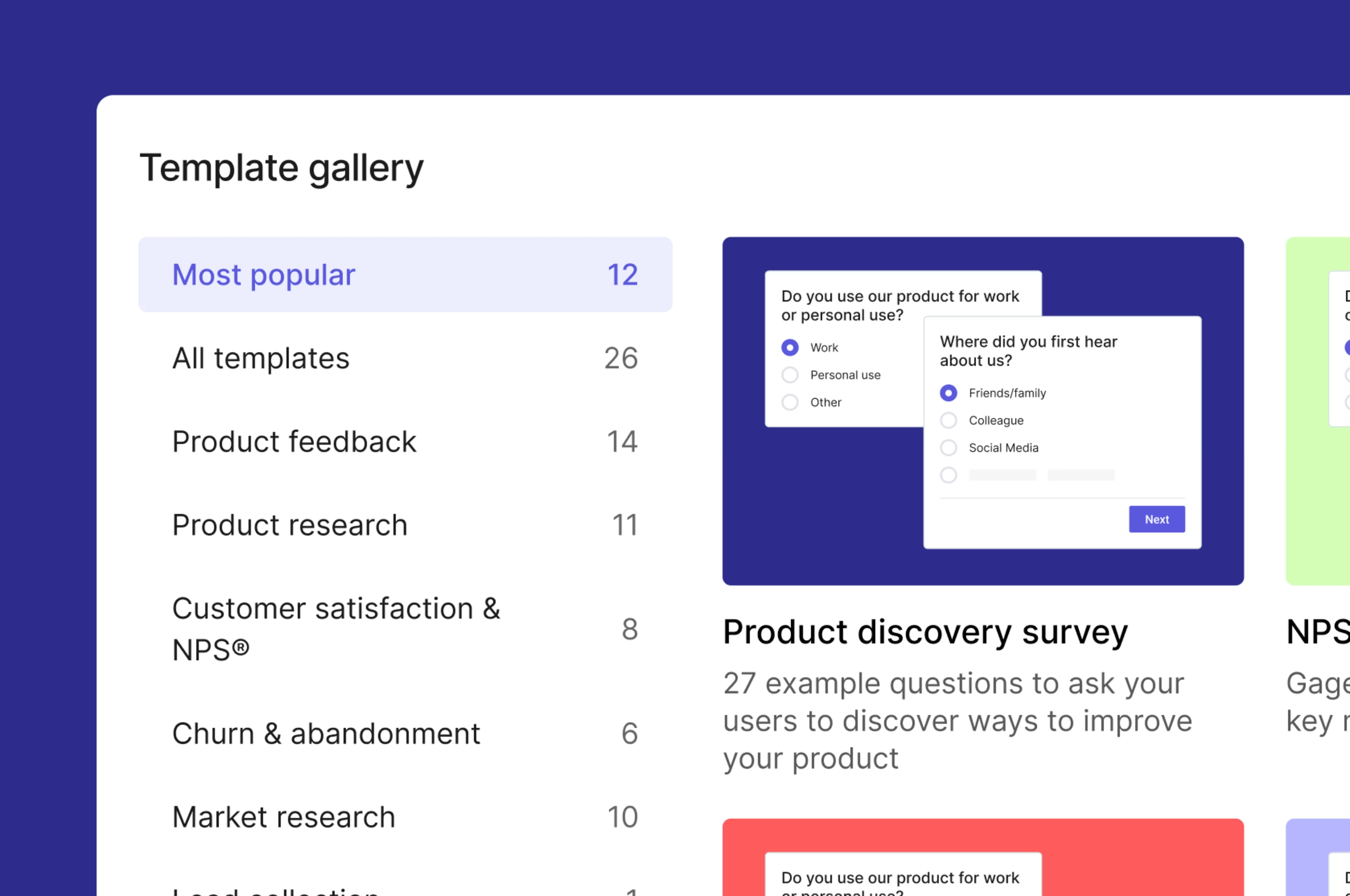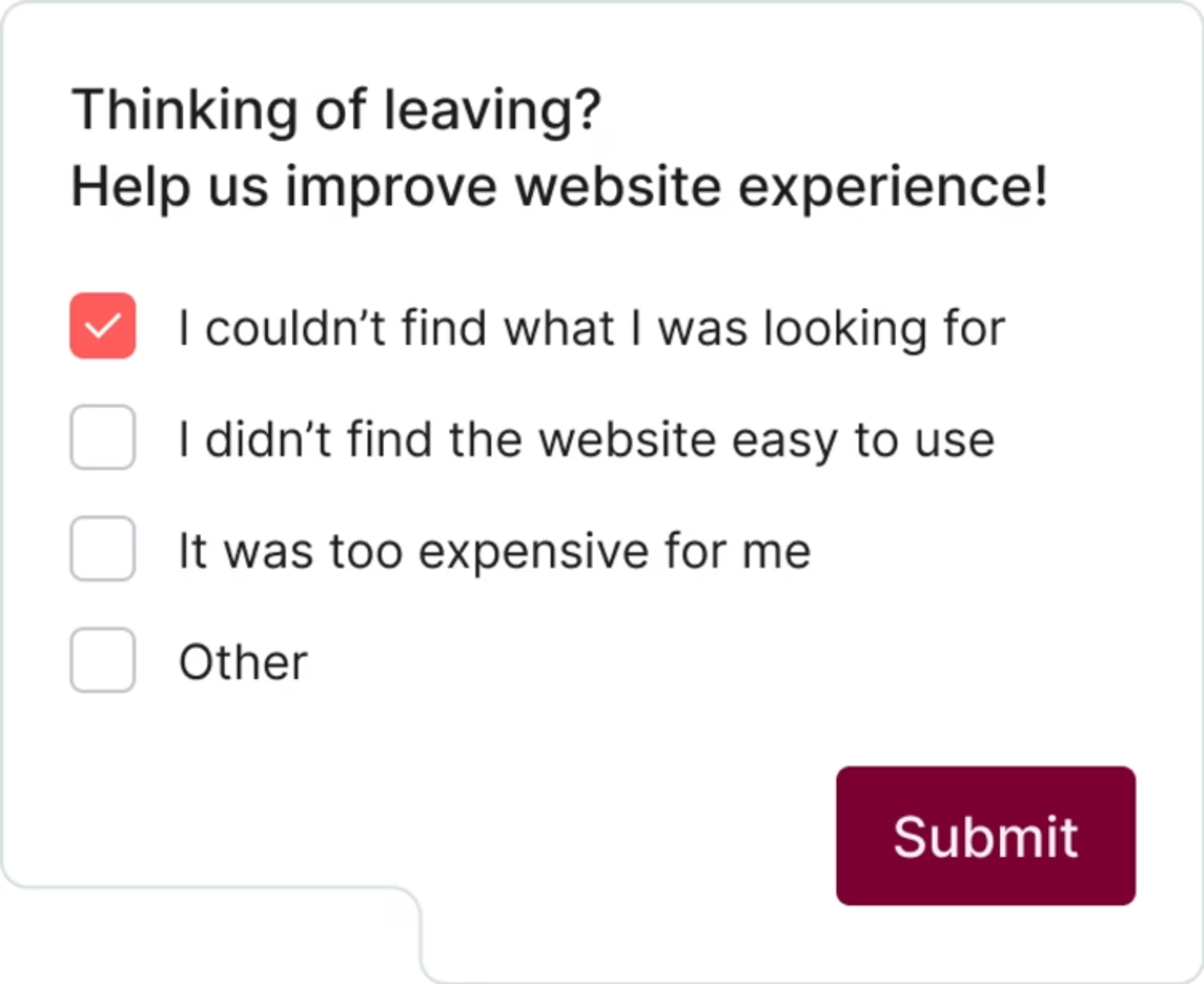How well do you understand your users? Who are they, what keeps them awake at night, and what brought them to your business in search of a solution? Nobody knows more about what your users want than your users themselves. So why not ask them?
Surveying people directly on your website gives you the feedback you need to improve the user experience (UX) and increase conversions. Writing ‘good’ survey questions and knowing when to ask them is paramount to ensuring you get the most out of your survey without wasting your or your users’ time.
In this guide chapter, learn about the different types of survey questions, what to ask, where to place surveys on your site, and how Contentsquare’s Voice of the Customer product makes drafting survey questions a breeze—it’s all not as intimidating as it might seem, we promise.
6 types of survey questions, examples of what to ask, and when to ask them
Posing survey questions to your users is the simplest way to understand their pain points, needs, and motivations. But first, you need to know what questions to ask—and when—to get the answers you need.
Let’s dive into our list of survey question examples with a breakdown of the six main categories your questions will fall into:
Open-ended
Closed-ended
Nominal
Likert scale
Rating scale
Yes/No
1. Open-ended survey questions
Open-ended survey questions give your respondents the freedom to answer in-depth and in their own words, instead of limiting their response to a set of pre-selected choices (such as multiple-choice questions, rating scales, or yes and no).
To get answers that hold valuable insights, you need to ask engaging and specific questions that invite your visitors to fill that empty text box with relevant customer feedback.
Examples of open-ended questions
What other [product/service] would you like to see us offer?
What could we have done better?
What led you to make this purchase?
What other information would you like to see on this page?
Was there anything specific that made you [cancel/downgrade]?
![[Visual] Examples of open-ended surveys, Market research](http://images.ctfassets.net/gwbpo1m641r7/1j7qjlKpDW37c6H4K8tApU/164629ceeec45a4ccc2fa026bcf57bdf/Screenshot_2024-11-04_at_19.36.31.png?w=3840&q=100&fit=fill&fm=avif)
Open-ended questions allow for survey responses with depth and context
When to ask open-ended questions
Ask open-ended questions when you first start surveying and collecting feedback from your customers. If you don't have a great deal of insight yet, answers to open-ended questions go a long way in determining who your customers are and what they're looking for.
An open-ended question is also a good follow-up to a closed-ended one: asking your users to share more details helps you get an even better understanding of how they feel.
Use Contentsquare’s AI to create survey questions and analyze answers in seconds
Do you have a general survey goal in mind but are struggling to determine the right questions to ask? Use Contentsquare’s Voice of the Customer to start writing survey questions.
Choose from our 40+ survey templates, or watch as our AI assistant generates one for you in seconds with questions tailored to the exact purpose of the survey you want to run.
Easily conduct survey analysis with our AI-generated summary reports that track user sentiment and provide an overview of key insights and suggest next steps for you to take based on your survey responses.

Use Contentsquare’s customizable templates or have our AI assistant generate survey questions in seconds
2. Closed-ended questions
Closed-ended survey questions limit a user’s response options to a set of pre-selected multiple-choice answers with checkboxes or rating scale answers. This broad category of questions includes
Nominal
Likert scale
Rating scale
Yes/no
We go over each one in the following sections, but let’s linger on the general category for a moment and see some examples.
Writing your survey questions in a closed-ended structure helps you easily quantify feedback when it comes time for data analysis.
Examples of closed-ended questions
What’s the main reason for your [downgrade/cancellation]? (List example reasons as answer choices)
Were you able to find the information you were looking for? (Yes/No)
How would you rate our customer support on a scale of 0–10? (0 = terrible, 10 = stellar)
How likely are you to recommend us to a friend or colleague? (NPS® question)
How would you feel if we discontinued this feature? (Emoji rating scale)
When to ask closed-ended questions
While they can be used just about anywhere, closed-ended questions work brilliantly in two scenarios:
To draw respondents in with a simple opening question, since they require little time and effort and are therefore easy for people to answer. This is called the foot-in-the-door principle: once someone commits to answering the first question, they might be more likely to answer an open-ended question that follows.
When you need to create graphs and trends based on people’s answers. Responses to closed-ended questions are easy to quantify and use as benchmarks. Rating scale questions in particular allow you to gather customer sentiment and compare your progress over time.
3. Nominal questions
A nominal question is a type of closed-ended survey question that presents respondents with multiple answer choices; the response options are non-numerical in nature and don't overlap (unless you include an ‘all of the above’ option). You can let users choose only one answer, or allow them to select multiple.
Examples of nominal questions
What are you using our [product/service] for?
✅ Business
✅ Personal use
✅ Other
Where did you first hear about us?
✅Social media
✅Word of mouth
✅Newspaper article
✅Advertisement
✅Other
If you could no longer use our [product/service], what would you miss the most?
➕ (List different features as answer options)
What's the next feature or functionality we should build?
➕ (List planned updates from your product roadmap as options)
What other content would you like to see us offer?
➕ (List content formats you haven’t used yet as options)
When to ask nominal questions
Nominal questions are perfect for market research and make for good demographic survey questions, when you want context about your respondents and target audience so you can segment them later. Nominal data is quantitative and easy to create graphs and trends from, so you can gain a nice overview of the behaviors and attitudes of your different user groups.
4. Likert scale questions
Likert scale questions typically use a 5- or 7-point rating scale that measures someone’s level of intensity to a statement. Likert scales are also known as ordinal scales because the answers are presented in a specific order.
The scale develops symmetrically: the median number (a 3 on a 5-point scale, for example) indicates a point of neutrality, the lowest number (always 1) indicates an extreme view, and the highest number (a 7 on a 7-point scale, for example) indicates the opposite extreme view.
Asking Likert scale questions is an effective method for turning qualitative data, such as customer sentiment, into quantitative data.

This quick customer satisfaction survey contains a 5-point Likert scale
Examples of Likert scale questions
On a scale of 1 to 7, how satisfied would you feel if we offered this [feature]?
Not satisfied at all
Not satisfied
Somewhat not satisfied
Neutral
Somewhat satisfied
Satisfied
Very satisfied
On a scale of 1 to 5, how much do you agree with this statement: Our [product/service] makes [X job to be done] easier.
Strongly disagree
Disagree
Neutral
Agree
Strongly agree
How would you rate the support you received?
Not helpful at all
Not helpful
Neutral
Helpful
Very helpful
💡Pro tip: ask different open-ended follow-up questions depending on the responses you get to your Likert scale. Ask those who answered 1–3, ‘How could we improve?’ and those who answered 4–5, ‘What did you love about the experience?’
When to ask Likert scale questions
Likert scale questions come in handy when you already have some sense of what your customers are thinking. For example, if your open-ended questions uncover a complaint about a recent change to your ordering process, you could use a Likert scale question to determine how the average user felt about the change.
5. Rating scale survey questions
Rating scale questions map possible answers on a numeric scale. For example, you can ask shoppers to rate customer support on a scale of 1–5 or the likelihood of them recommending your product on a scale of 0–10 (also known as a Net Promoter Score®).
When you use a rating scale question in a survey, make it clear what the scale means (1= poor and 5 = amazing, for example). Consider adding a follow-up open-ended question to understand why the user gave you that score.
Examples of rating scale questions
On a scale of 1–10, how appealing do you find our product offering?
On a scale of 1–5, how helpful is the information on this page?
How easy was it to use our service? (Customer effort score)
![[Visual] Feedback button - How would you rate your experience](http://images.ctfassets.net/gwbpo1m641r7/6zpie5F6Gwd4oyqXaxBfcN/b7e9b7f3bfcc6265f47b5294d8fec319/Feedback_button.png?w=3840&q=100&fit=fill&fm=avif)
Use a rating scale question to measure NPS®, then follow up with an open-ended question to gain more context
When to ask rating scale questions
Whenever you want to assign a numerical value to your survey or visualize and compare trends, a rating scale question is the way to go. This type of question is often used for customer satisfaction surveys, customer effort score surveys, and product reviews.
Add an NPS® survey question to your site with Contentsquare
Use Contentsquare to set up an NPS® survey and trigger it to appear after important events, such as when a user completes a purchase or accesses support.
A low NPS® alerts you to improvements you need to make, while a high NPS® gives you an idea of what to prioritize to boost customer retention. The response format allows you to look at results historically and see if you’re improving or getting worse.
6. Yes/No questions
Binary or dichotomous questions are super straightforward, requiring a simple ‘yes’ or ‘no’ reply. Though this question type has the most limiting answer options, it helps you gain a quick sense of user sentiment or the effectiveness of a particular product feature.
To make the question even more engaging, try replacing yes/no with 👍and 👎 or 🙂and 🙁.
Examples of yes/no questions
Was this article useful? (Yes/No)
Did you find what you were looking for today? (👍/👎)
Did you have any concerns before buying [product name]? (Yes/No)
When to ask yes/no questions
Yes/no questions are a good way to quickly segment your respondents. For example, say you’re trying to understand what obstacles or objections prevent people from trying your product. You can place a survey on your pricing page asking people if something’s stopping them, then follow up with the segment who replied ‘yes’ by asking them to elaborate further.
A yes/no question also helps you get your user’s attention because it requires very little effort to answer. Once they commit to answering that first question, they tend to become more willing to answer questions that follow, or even leave you their contact information.
Dig deeper into questions by running user interviews and usability tests
Speaking of getting your foot in the door to unlock more insights from your survey respondents, why not ask them to do a follow-up interview or usability test with you?
Contentsquare makes it easy, scalable, and cost-efficient to connect with your users:
Run effortless, automated user interviews and unmoderated usability tests in less than 10 minutes
Get instant access to a pool of 200,000+ participants from over 130 countries and 25 industries (or invite your own)
Take notes while Contentsquare records and transcribes your interview, then highlight moments that reveal key customer insights and share them with the team
Identify site errors or validate design concepts, content, and messaging with iterative usability testing to ensure you meet user expectations
Where to ask your survey questions
If you want your users to answer questions and provide feedback that contains actionable insights, you need to ask your survey questions at the right place and time.
Ask yourself these questions to determine where to place your surveys:
What pages are crucial to your business?
Which over- or under-performing pages could most benefit from additional insight?
Where along the customer journey or conversion funnel have you spotted a leak that needs investigating?
💡Pro tip: if you want your users to fill out a somewhat longer questionnaire, you can also send your questions as a link survey via email or post it on social media. Be mindful of their time—minimize the number of questions or consider incentivizing participation.
Carefully considering which pages to ask a question on before you start writing one helps improve your chances of getting truly valuable survey data instead of unhelpful answers that won’t lead to improvement.
Here are five likely candidates for where to ask your survey questions:
Homepages
Landing pages
Success and post-purchase pages
Pages with high exit or bounce rates
Cancellation, downgrade, or churn pages
![[Visual] Exit-intent survey](http://images.ctfassets.net/gwbpo1m641r7/70LxdbnLg3vHHjjMfZjfmb/ae68013aad3713169bfcac7b7ab1c795/image3.png?w=1920&q=100&fit=fill&fm=avif)
Contentsquare has pre-written questions you can place on specific pages, like those with high exit rates
What makes a ‘good’ survey question?
To make the most of your survey, you need to know how to write good questions that give you answers you can act upon.
We’ve run through a handful of our favorite survey questions—but what is it that makes a good survey question, well, good? The goal here is effectiveness: the best survey questions help you get clear insights and business-critical information about your customers, including
Who your target market is
How to price your products and services
What’s stopping people from buying from you
Why visitors leave your website
With this information, you can tailor your website, products, landing pages, and messaging to improve the user experience and, ultimately, maximize conversions.
💡Pro tip: the more attention you put into writing your survey questions, the easier it is to analyze the data you collect. Read the dedicated chapter to learn how to conduct survey analysis.
Survey question dos
Focus your questions on the customer’s perspective to understand their needs, drivers, pain points, and barriers
Tailor the language to your target audience
Be polite and concise—if needed, break things down into separate questions to make for a better survey-taking experience
Consider the foot-in-the-door principle and start your survey with a simple yes/no question, then follow up with an open-ended question to increase the response rate
Survey question don’ts
Don’t ask double-barreled questions and stick to one topic per question
Don’t rely on closed-ended questions at the beginning of your research process—start with open-ended questions to gain an initial impression of your customers and avoid reinforcing your own assumptions
Avoid asking loaded or leading questions that prompt respondents to answer a certain way—for example, rephrase “Is our product the best on the market?” to “How does our product compare to other options on the market?” so respondents can answer more freely
Asking the right survey questions is only the first step
Asking the right questions sets you up to achieve your survey goals—it helps you optimize your customer journey, analyze product-market fit, increase customer satisfaction, and redefine your messaging. Read the dedicated chapter to learn how to create an effective survey with your user and business goals in mind.
That said, online surveys aren’t enough in and of themselves to get a comprehensive picture of your customer experience. To gain a richer understanding of your users, combine survey data with insights from tools like session replays, heatmaps, web traffic analytics, or journey mapping.
Here’s how to do that with Contentsquare:
Discover issues and understand what’s causing them by watching Session Replay of users who leave negative survey feedback with Session Replay
Reveal the behavioral context behind how users interact with your website or product with Heatmaps
Build user segments from your survey responses and follow their user journeys with Journeys

![[Visual] Contentsquare's Content Team](http://images.ctfassets.net/gwbpo1m641r7/3IVEUbRzFIoC9mf5EJ2qHY/f25ccd2131dfd63f5c63b5b92cc4ba20/Copy_of_Copy_of_BLOG-icp-8117438.jpeg?w=1920&q=100&fit=fill&fm=avif)